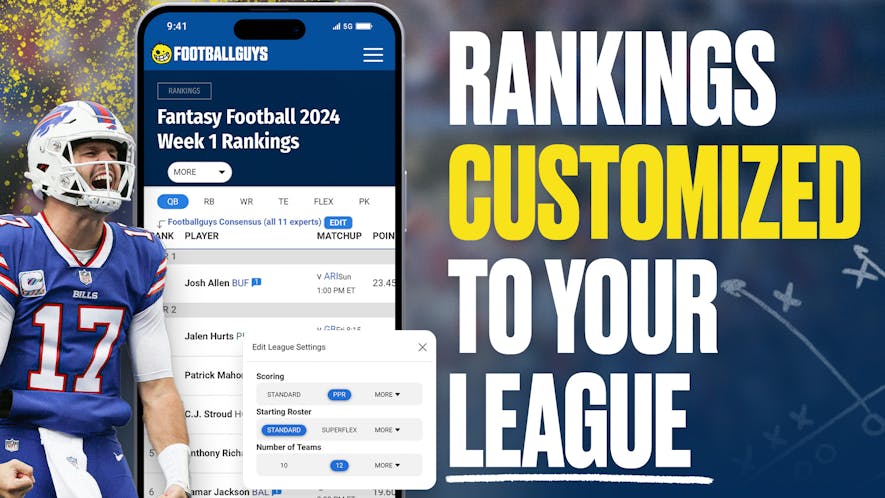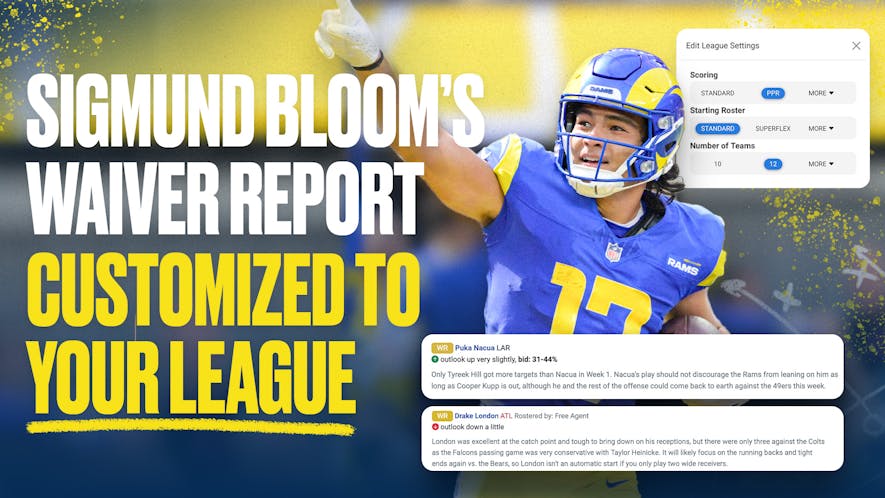
The Footballguys staff got together to discuss various dynasty-themed topics as we head into the offseason. This series of articles is designed to give you a boost of knowledge on the dynasty front covering several relevant and pertinent topics over the course of the offseason. Below is the second installment of our collaborative discussion.
Other offseason dynasty discussions
- When is the best time to deal players and picks?
- What are some tips for unloading a player who is past his peak?
- Which aging veterans are you targeting in the offseason?
- What is your perceived dynasty value of impending, notable free agents?
Picking the right time to sell high and buy low on a player is an art form. What tips and tricks have you learned to incorporate as a dynasty owner regarding this strategy?
Sigmund Bloom
The first counterintuitive piece of advice I'll give here is that moves that feel irrational at the moment can end up being your most brilliant trades. When you yourself are reluctant to trade a player because he feels that essential to your team, that is a sign that your trade partner might be willing to go the extra mile to make the deal work for you.
The best way to time buy-low and sell-high deals is having your finger on the pulse of just how the fantasy football community feels about a player. Monitoring ADP, participating in offseason best-ball drafts or mock drafts, and participating in the community and conversations on Twitter or in the Shark Pool are all good ways to do this. The buy low/sell high takes should come naturally as you'll find out quickly where you think the market is off and where action is called for.
Jason Wood
In a perfect world, you want to sell a player when the majority still view them as ascending. But it's as difficult for you to correctly forecast the cliff as anyone else in your league. So there's risk to it, but it's worth doing particularly if you're trying to achieve a specific goal in mind to improve your roster. I always start the process by looking at outlier performances from the prior season. If a receiver had 10 touchdowns on 50 targets, I'll view that as someone whose value is going to trend lower. If a receiver has 2 touchdowns on 130 targets, I'll view that as someone worth targeting. Each position has players who put up stats that don't match their underlying usage (both positively and negatively) and human nature always overvalues the box score versus the underlying skill set.
Dave Kluge
Textbooks could be written on this question, but to sum it up as briefly as possible, trading a player when they are at their absolute prime production is a good rule of thumb. Now, that’s easier said than done. But typically, you want to view your dynasty assets in a similar way to how you’d view the stock market, never wanting to buy at an all-time-high or sell on the way down. It’s difficult to trade a player coming off a great season, but shipping off those top-tier players for a bundle of high-upside assets is a great way to assure that you stay competitive for years to come.
Like all art forms, you have to be willing to put yourself out there and take risks. Sometimes you will make massive mistakes, other times you will hit a home run.
Age is the simplest factor, but it is more complex than that. How many career carries does your running back have? How many injuries has your wide receiver endured? How many offensive coordinators and head coaches has your quarterback had to suffer through?
Has your player had an incident that prompted you to think he may be a future risk? I can remember trading away Antonio Brown when he was the No. 1 fantasy receiver purely because I thought he was becoming unstable. He was the top receiver the next year, but my gut feel was ultimately correct and I sold high. I traded George Kittle away early in his career as I thought he didn’t excel in any area. We all make mistakes, but not only should you exercise your judgment you should follow up and analyze your mistakes and don’t make the same one twice.
Does anyone go as far as have a notebook on other leaguemates, have a trade log to reference, or anything like that?
Yes! Familiarize yourself with your leaguemates and their strategies. This is important. I review past trades between leaguemates as well as review my own past trades and discussions. Most of my leagues are through the Sleeper app so I look through past messages to keep track. I also keep a personal notebook for some past trades I’ve discussed or completed. I like to be efficient with my time and discussions so understanding past trading habits of my leagues helps with future trade discussions in regards to which teams to target.
How do I know when to pull the buy or sell trigger? Knowing motivations is the key as I mentioned earlier. If you see a team who is struggling, approaching that owner with "Are you looking to start rebuilding now?" may be a good approach. If you see teams on the bubble who may be looking to solidify their team, it can be a good time to ask "Are you willing to give up some future to win now?"
The most important thing in a trade is coming up with a strategy where both teams benefit from the deal. You see this with fantasy trading in general - the owners who only see the benefit from their side and not from the other owner's perspective. In a dynasty league, owners always consider "What happens next year?" when considering a trade. If a one-sided offer comes in, owners can become frustrated and simply ignore the offer or reject it without a counter. If you really want to make a trade with another team, both owners need to feel they are better off from it.
Jeff Haseley
Chad, what about you? What tricks and tips do you have? I know you have some.
Chad Parsons
Use a foundation of a player's profile, historical probabilities to sustain their production (or rise in production) as the backbone of analysis, especially in the early years of a player's career. Also, a down year by an annual long-standing producer (or season-ending injury) can be the lone window to get a discount on a rock-solid profile. Embrace risk when warranted with an elite profile and properly discounted. Fade flash in the pans when the pan gets too hot for their profile. The trick is not overvaluing the long-range importance of a single week, matchup, or short dynasty stint inseason to hold likely short-term producers through their lone window to cash out. Also, even if you generally love (or hate) rookie pick valuations, learn to leverage the market through trading to fit your strengths. Scout prospects and profiles well? Get more picks. Struggle with a lower success rate than your league peers in rookie drafts? Leverage that by trading picks away for veteran profiles, but timing the market and hand-selecting veteran profiles.
Jordan McNamara
Don't forget about data as a guide. The easiest way to find low-hanging fruit is to look for players that had outlier seasons at regression statistics. Points-per-target is essentially random year to year. If wide receivers had north of 2 points per target, they are due for a regression back towards the 1.65 historical average. Same with guys below the historical average, you should expect them to see an uptick.
For quarterbacks, target those who had a touchdown rate below 4% as buy candidates, and those above 7% as sell candidates. Also, if a running back has a low yards-per-carry despite a high volume, they are a classic buy candidate.
Adam Wilde
For selling, I tend to try to trade running backs coming off of top-tier seasons or when they're entering the fourth year of their contract. I specifically target younger running backs who aren't considered to be equivalent value yet. An example of this would be trading Nick Chubb for Antonio Gibson plus some sort of rookie pick or ascending player to fill the value gap. This strategy has a reasonable probability to miss, but if you choose the right backs to pivot to you can avoid tricky contract situations and changes of scenery.
Questions, suggestions, and comments are always welcome to haseley@footballguys.com


